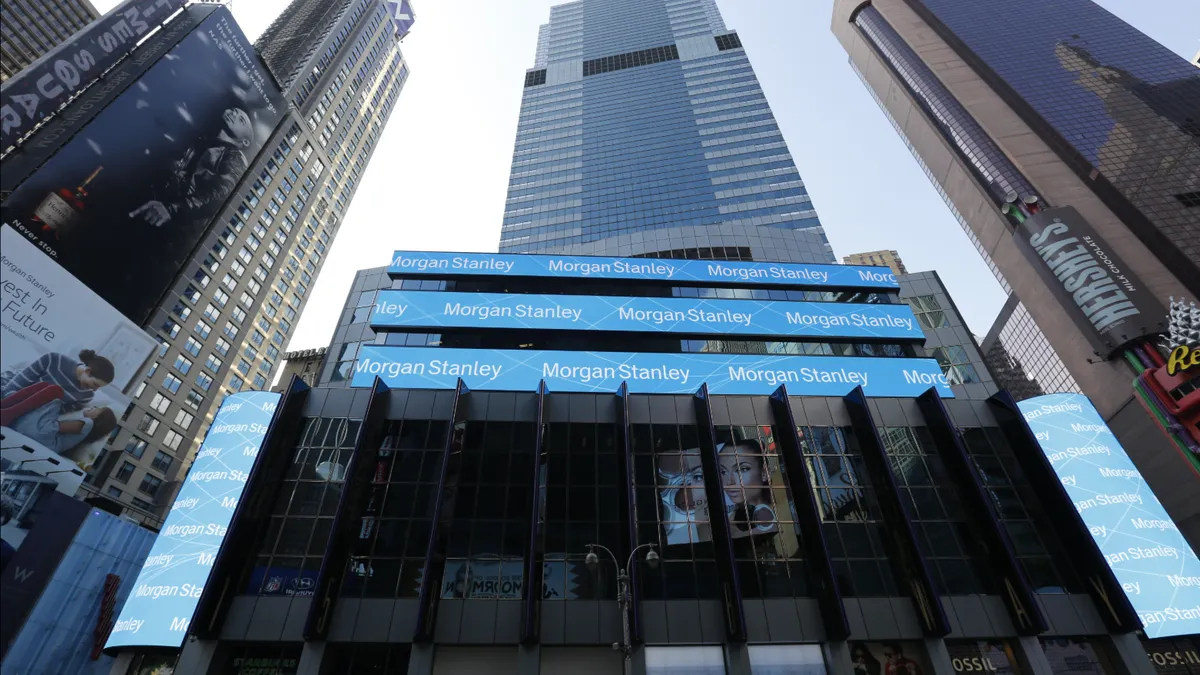More often than not, when one major bank takes a stance — on any issue from environmentally conscious investing, to hiring a diverse workforce, to pandemic-induced work policies — its competitors are generally swift to follow if the move is seen as positive, or redirect if it fails.
It may be surprising then that the herd hasn't chosen a direction on the issue of employee bonuses, seeing that three of the nation's six largest banks have made their stance public.
Morgan Stanley said Thursday it will give most employees earning less than $150,000 a year a one-time $1,000 bonus, according to a note sent to staff seen by Bloomberg.
"To say 2020 has been an extraordinary year in not only our firm's history but the world's would be an understatement," CEO James Gorman said in the note.
Roughly 30,000 employees — about half the bank's workforce — are slated to receive the bonus, which comes during a year when Morgan Stanley is on pace to hit a company record for revenue, about $45 billion, according to Bloomberg estimates.
The bank immersed itself in two multibillion-dollar acquisitions this year — first, a $13 billion purchase of E*Trade in February, and then a $7 billion agreement to buy investment management firm Eaton Vance in October.
Morgan Stanley could be seen as a pace-setter in COVID-19 response. Gorman was the first of several CEOs to announce his bank wouldn't lay off any employees in 2020. Bank of America quickly followed suit, while others such as Citi and Wells Fargo, temporarily paused expected efforts to shrink headcount.
The investment bank isn't the only Wall Street juggernaut to weigh in on bonuses. JPMorgan Chase announced last week it may increase variable compensation for traders by 15% to 20%, sources told Bloomberg. JPMorgan, too, saw record revenue during the first nine months of 2020 — to the tune of $23.5 billion.
However, a 20% boost in bonus pay may be seen as a disappointment in a sector such as trading, which saw a 48% jump in revenue, according to Bloomberg.
Still, that would be more generous than a plan Bank of America's senior executives suggested last month — to keep the bonus pool for sales and trading at last year's levels despite a 20% boost in revenue at the bank during the year's first nine months.
Morgan Stanley's plan is the only one of the three to extend bonuses beyond the desks most responsible for revenue, yet it mirrors early COVID-era efforts to recognize front-line employees whose jobs couldn't be done remotely.
Morgan Stanley broke rank with other banks of its size with regard to pay at the top, as well. Gorman's total compensation in 2019 fell 7% even though the bank saw profit jump 46% last year. That stands in contrast with Goldman Sachs, which gave its CEO David Solomon a nearly 20% raise, despite announcing in January that it would trim $1.3 billion in operating costs.
A look at another country's top banks shows how comparatively little their bonus pools vary in 2020. Canada's six biggest banks are setting aside 3.9% more, on average, for bonuses this year than last. That ranges from a 6.2% boost at TD to a 1.3% decrease at Scotiabank, according to Bloomberg.
Perhaps the U.S.'s other big banks are keeping their bonus plans closer to the vest, or are waiting to see how the fourth quarter shakes out. (Again, it should be noted that Citi, Wells and Goldman all are cutting their workforces.) But for once, the banking industry may have found an issue for which the response is completely individual.














